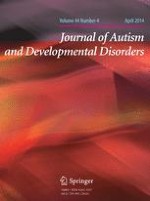01-04-2014 | Original Paper
National Survey of Sensory Features in Children with ASD: Factor Structure of the Sensory Experience Questionnaire (3.0)
Gepubliceerd in: Journal of Autism and Developmental Disorders | Uitgave 4/2014
Log in om toegang te krijgenAbstract
This national online survey study characterized sensory features in 1,307 children with autism spectrum disorder (ASD) ages 2–12 years using the Sensory Experiences Questionnaire Version 3.0 (SEQ-3.0). Using the SEQ-3.0, a confirmatory factor analytic model with four substantive factors of hypothesized sensory response patterns (i.e., hyporesponsiveness; hyperresponsiveness; sensory interests, repetitions and seeking behaviors; enhanced perception), five method factors of sensory modalities (i.e., auditory, visual, tactile, gustatory/olfactory, vestibular/proprioceptive), and one of social context were tested with good model fit. Child and family characteristics associated with the sensory response patterns were explored. The effect of sensory response patterns on autism severity was tested, controlling for key child and family characteristics. The SEQ-3.0 demonstrates an empirically valid factor structure specific to ASD that considers sensory response patterns, modalities, and social context.
